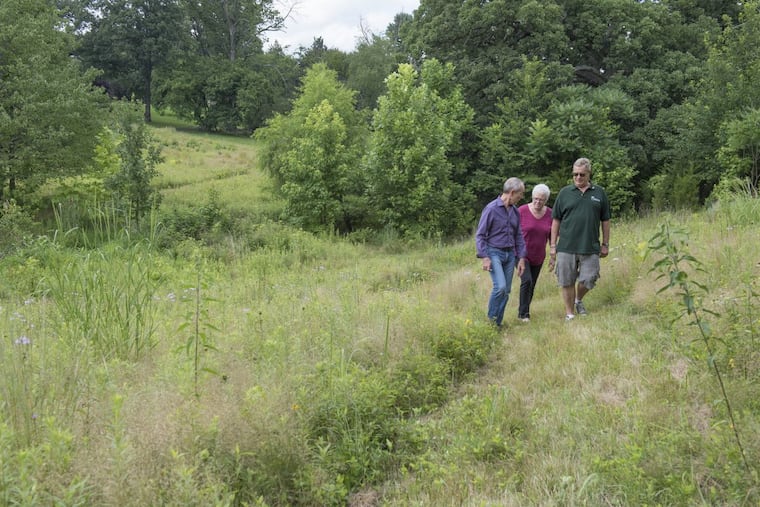A happy 115th birthday to Trenton's Cadwalader Park
The 100-plus acres on Trenton's west side are the last great urban park designed by Frederick Law Olmsted, who designed Central Park.

The balloon man, the lawn bowlers, and the bears are long gone.
Same for the boat rides, the cricket matches, and (most of) the deer.
But the beauty of Trenton's Cadwalader Park endures.
And as this sylvan oasis — designed by Frederick Law Olmsted, the father of American landscape architecture — marks its 115th birthday, people who treasure the city's biggest park are working hard to make sure it not only survives but also thrives.
"There's a lot of enthusiasm, a lot of commitment to protect and upgrade the park," Trenton Museum Society trustee David Bosted says. "That's a real good sign for the future."
I meet Bosted and three other advocates — like him, retired or semi-retired professionals — at Ellarslie, the 19th-century mansion that houses the museum and serves as both centerpiece and symbol of Cadwalader Park.
The museum's offerings are first-rate but, like the surrounding 100 acres, Ellarslie itself needs some work; in 2001, an updated master plan pegged the total cost of upgrading the park at $22 million.
A $2.4 million, state- and city-funded project is under construction and includes a handsome new picnic pavilion and playground. Welcome additions, indeed, but the park's graceful, curving drives — an Olmsted signature — need repaving. Too many trees are visibly diseased, dying, or dead.
Meanwhile, Ellarslie's roof leaks rather badly, and some folks believe a vestigial scent from decades ago when the house was home to a primate collection and was known as "The Monkey House," is occasionally detectable.
I detected no such thing when I visited last Wednesday. But I did enjoy five marvelous galleries of photographs, paintings, and memorabilia in the deftly curated "Cadwalader Park — An Olmsted Vision" exhibit, which attests to the significance this special place holds in the community's collective memory.
With elements of a carnival, zoo, cultural center, and nature preserve, Cadwalader Park was once known as "Trenton's Pleasure Ground." It was like a day resort for families, a genteel place where ladies carried parasols and children engaged in picturesque activities such as launching toy boats.
The park was a regional destination into the 1960s and continues to draw many local residents, as well as young tennis players to its recently rebuilt courts. It still offers glorious meadows, magnificent arbors, and scenic glimpses of the Delaware and Raritan Canal, which is carried above the Parkside Avenue tunnel via a majestic little aqueduct. The structure is featured in vintage postcards.
"With the exhibit, we're trying to show the grandeur of the park, and how the park was utilized by the public, and is still utilized by the public today," says trustee Karl Flesch, who can be seen enjoying one of the popular Cadwalader kiddie rides in a 1959 photograph on display.
The gallery show continues through Sept. 17, as does an accompanying series of concerts and lectures (Bosted's talk on Olmsted is set for Sunday, Aug. 13). The anniversary festivities will culminate Sept. 16 with the annual house and garden tour sponsored by the Cadwalader Park Alliance in the adjacent Cadwalader Heights neighborhood. Olmsted laid that out, too.
"This is the only public park in New Jersey designed by the FLO himself. That's our cachet," notes Randy Baum, who served as Trenton's landscape architect for 17 years. "Branch Brook Park in Newark and others in North Jersey were designed by his firm."
Baum moved to Cadwalader Heights, which is across Parkside Avenue from the park's main entrance, in 1986, and knows the stories of pretty much every house, if not every tree. "I love living here," he says. "It's a very tight community."
Like the nearby Hilltonia and Berkeley Square neighborhoods, Cadwalader Heights features fabulous high-style houses and verdant, curving streets somewhat at odds with prevailing perceptions of New Jersey's capital city.
This Olmsted legacy "adds something to Trenton and portrays us in a better light," says Sally Baxter, who also lives in Cadwalader Heights and works as an assistant to the trustees.
But the benefits are deeper than mere positive imagery: "Living near and working in the park," says Baxter, "I see it being used and enjoyed on a daily basis."
Doing so on the day I visit is Antonio Pineda, 25, of Ewing Township, who has long enjoyed the park but says it "needs more attractions for kids" and could stand some sprucing up.
The city "could take better care of this gem," says Ed Wengryn, 53, a friend of mine, who has lived in the city's historic Mill Hill neighborhood since 2009 and enjoys Cadwalader Park.
"Spaces like it make the city livable and desirable," he adds, likening the impact of the park's appearance to that of a well-kept front yard on a home's curb appeal. "When your front yard is well-maintained, people are attracted."
Despite its plush-sounding name — Thomas Cadwalader was the first burgess, or mayor, of Trenton — "the park was always meant to be for the people of the city," Flesch says.
"It wasn't meant for the rich."
So even in a post-burgess, post-parasol era, the curving roads, leafy landscapes, and unexpected vistas that put the park on the map 115 years ago retain their calming, even inspiring, charm for anyone who cares to visit.
"Cadwalader Park was Olmsted's last urban park," Bosted says. "And it's a great one."
It certainly is.